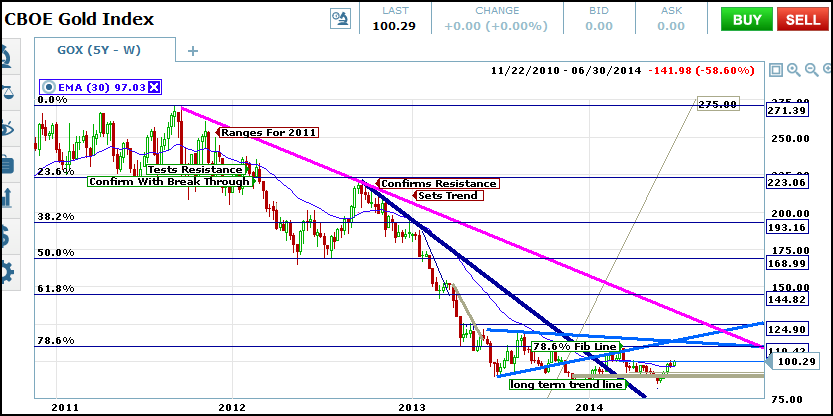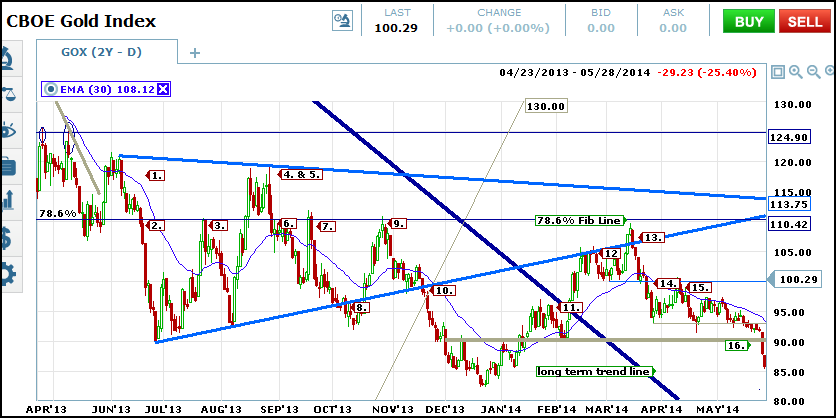Trading Both Sides Of The Chart – Down Trends
I began a discussion on when to use bearish positions in an earlier article. In that piece I focused on trading ranges and the use of oscillators like MACD, stochastic or RSI. Trading ranges, or the limits of those ranges, present high probability target areas in which signals can be taken, both bullish and bearish. They are also ideal situations for using overbought/oversold readings on your indicators as they often lead to and/or confirm the tops and bottoms of a ranging market. For this piece I am going to focus on an actual bear market. In general, even when we are in a secular bear market, stocks tend to go up slowly and fall quickly. It is not rare, but uncommon to find an asset in a true down trend but one you do it can provide a number of text book entries. I have been following a down trending asset for some time now, at least three years, and was inspired to write this article when I read Cory’s article about using another gold stock or index as an indicator of physical gold prices. I like to use the CBOE Gold Index, or GOX.
Long Term Down Trend In Gold
During the financial crisis of 2008-2009 the price of gold went through the roof, taking gold stocks and gold indices with them. At the peak, gold was trading over $1800, about 50% higher than the current levels. Since then, roughly 2011 or so, gold prices have fallen in a steady down trend with gold stocks moving right along with it. The down trend in the gold sector is a near perfect text book example and readily observed in numerous time frames. Along the way there are quite a few signals, bearish signals, to trade on. I know for me it was hard to learn just when to trade bearish and bullish as so many indicators can produce either form of signal at any given time. It took a while but I eventually began to understand the importance of trend, time frame and the relative value of any one signal at any one time. A bear signal in an uptrend isn’t a good place to get into a long term bearish position any more than a bullish signal in a down trend.
The first step is to identify the down trend. On the chart below it is easy to see the long term down trend in the GOX but how might you find it way back when it first started? That is the hard part and why waiting for confirmations are always a good idea. We can see that the index traded in a range during all of 2011 between two key Fibonacci Retracement levels. During this time range trading techniques and short term trend following strategies would have been a good idea. At the end of the year price broker the lower boundary, retested the moving average and produced bearish confirmation. This signal is still rather short term in nature but still a good place to buy puts, only there really isn’t a trend established yet. That happens later in 2012 when prices retest the previously broken 23.6% Fibonacci Retracement. Once that happens a well defined down trend ensues. At this time moving down to a chart of daily prices and even shorter to 1H or 30M will produce repeated trend following signals, signals identical to bullish signals, just in reverse. In fact, there are even some well defined longer trend signals as well. Look to the extreme right of the chart where I am tracking a pennant formation.
Bearish Entries For Short Term Traders
In this next chart I drill down to daily charts with a close up of the long term pennant mentioned above As we can see bearish traders are presented with a number of opportunities for entry along the boundaries of the pennant itself and the Fibonacci Retracement lines drawn on the bull trend leading to the down trend we are tracking today. There are at least, and I say at least, 16 positive bearish signals over the course of a year. This is great for patient traders with a long term outlook and also provides starting points for short term traders. Each time one of these signals appears on the daily charts that is your ticket to move down to a chart of short candles in order to capture the shorter term movements, always keeping in mind the underlying trend and taking only the bearish trades.
Studying old charts and historical price action is important to do. By studying old charts, drawing trend lines, playing with Fibonacci Retracement and identifying where the really good signals come from you get comfortable with them. This comfort level will help you with your trading because you will be better able to recognize new signals as they happen. Each new down trend will be different but in the end the market is always repeats itself and those repetitions will show up on your charts.

